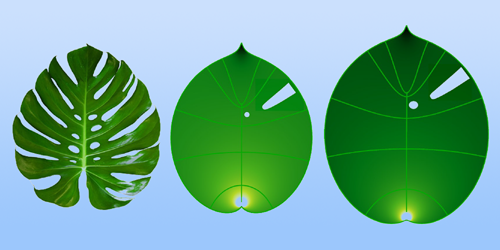A Conformal Map Model for Leaf Growth
In his 1917 book, On Growth and Form, D’Arcy Thompson pioneered the use of mathematics in biology. Now physicists Anna Dai and Martine Ben Amar of the École Normale Supérieure in Paris have taken a page from the century-old book. Noticing that many of Thompson’s diagrams showing plant and animal growth look like conformal maps—angle-preserving transformations—Dai and Ben Amar applied the mathematics of conformal maps to the problem of leaf growth [1]. They prove that the mathematical technique is well motivated by the physical principle of energy minimization.
Many growth processes in biology reflect the fact that, like all physical systems, organisms want to minimize their energy. For growing organisms, that means minimizing internal elastic stresses.
But this energy-minimization picture of growth is seemingly unrelated to the mathematical one that Dai and Ben Amar observed in Thompson’s book. Imagine drawing a grid on a baby leaf and watching the grid distort as the leaf grows. If the leaf grows conformally, the lines will stretch and curve, while the angles at which gridlines intersect remain unchanged. At first glance, this simple mathematical transformation doesn’t seem to tell us anything about the physical forces involved in leaf growth.
Nevertheless, Dai and Ben Amar found that it encapsulates the salient features of the complex physics at play. Focusing on leaves from the Monstera deliciosa (or “Swiss cheese”) plant, they showed that conformal maps reproduce leaf growth while minimizing elastic stress, making the mathematical transformation physically well motivated. So far, the researchers have performed their analysis in 2D; next, they plan to explore whether conformal maps can be used to describe the growth of 3D leaves.
–Katie McCormick
Katie McCormick is a freelance science writer based in Sacramento, California.
References
- A. Dai and M. Ben Amar, “Minimizing the elastic energy of growing leaves by conformal mapping,” Phys. Rev. Lett. 129, 218101 (2022).




